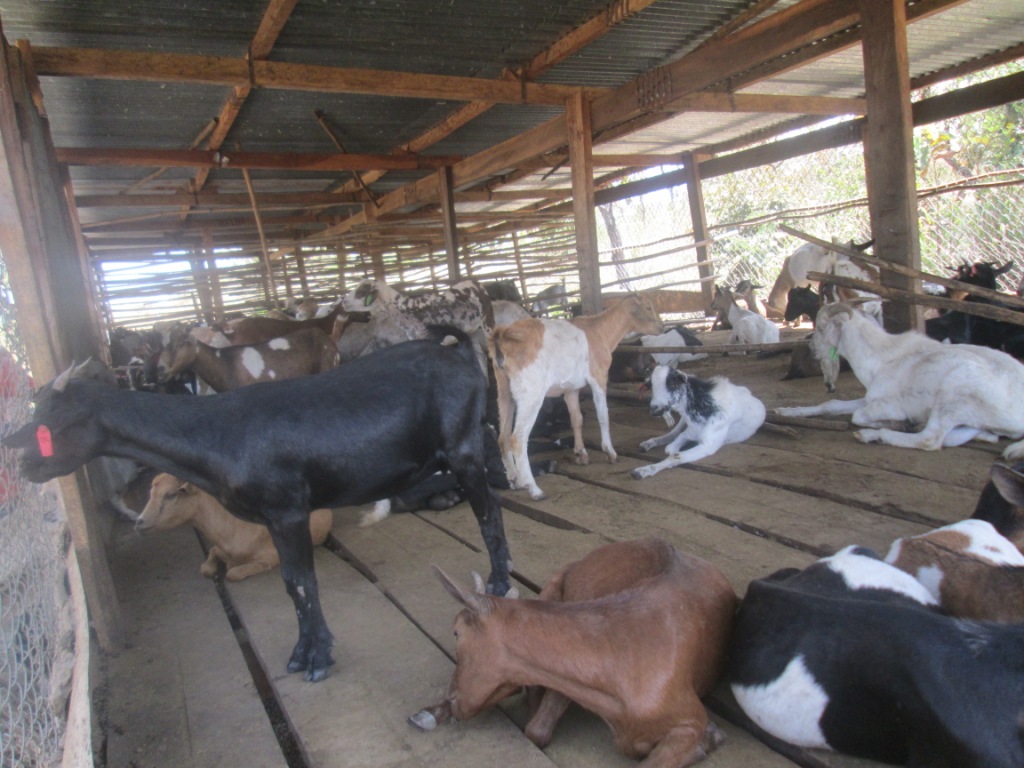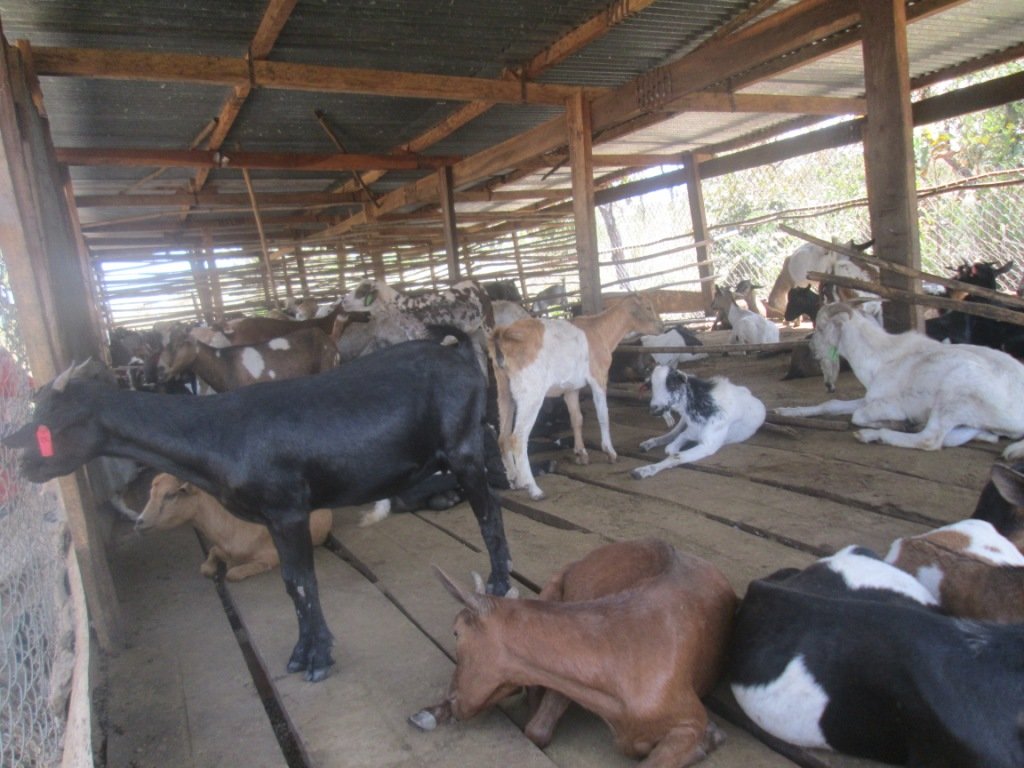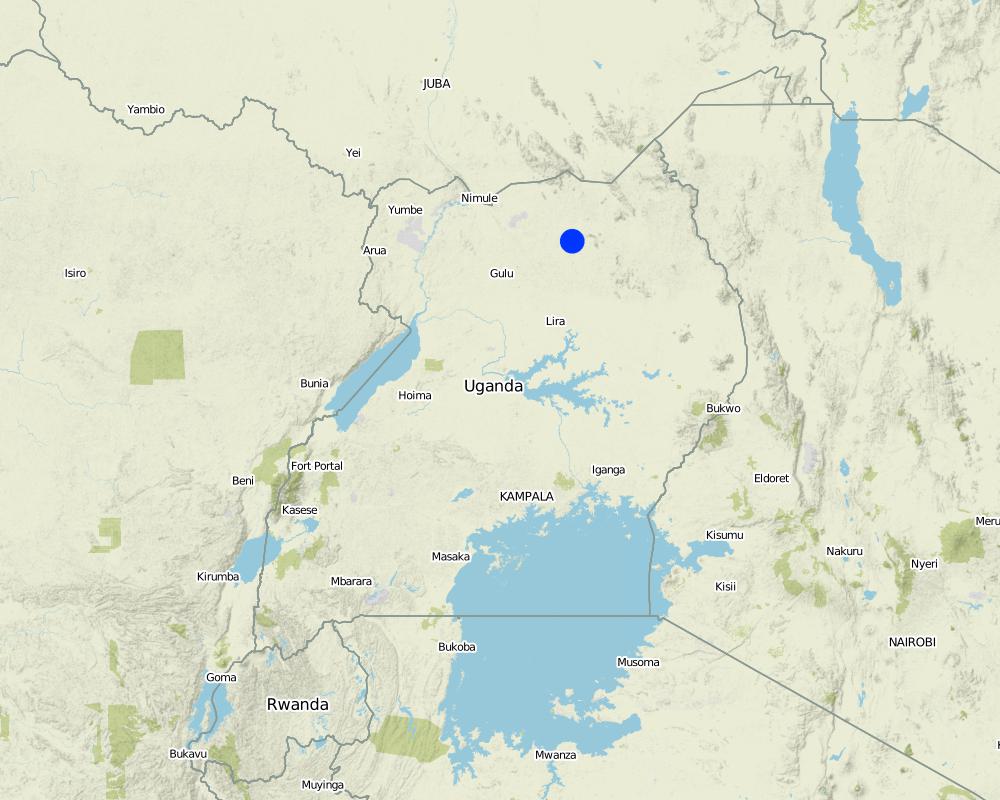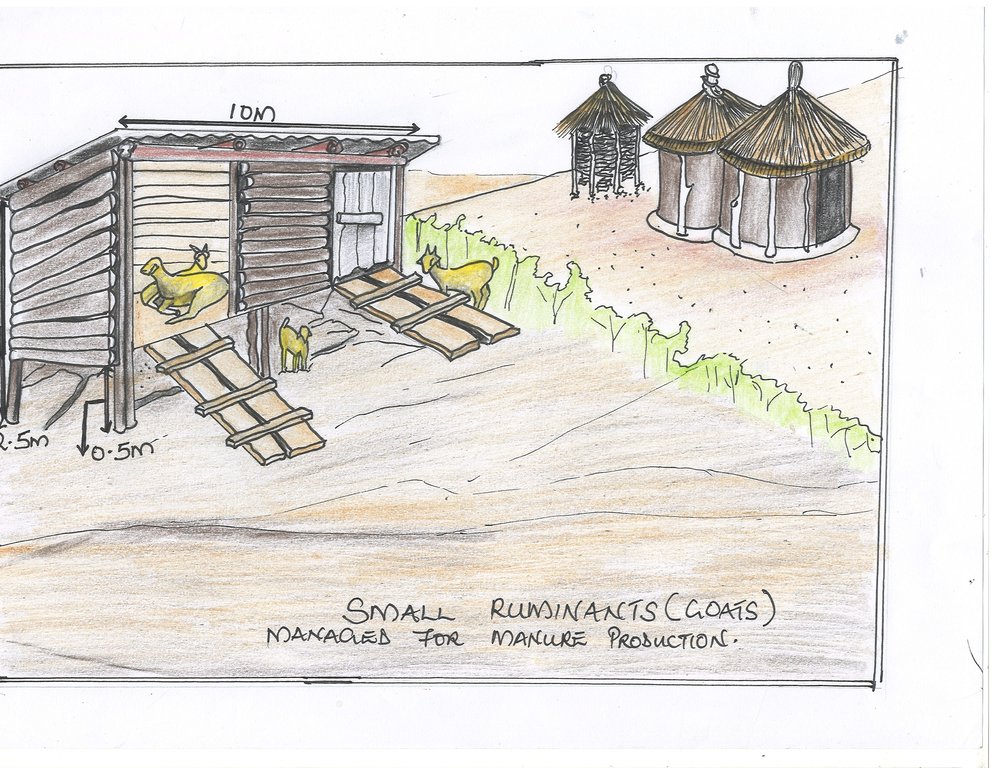Small ruminant management for manure production (goats) [Uganda]
- Creation:
- Update:
- Compiler: Kamugisha Rick Nelson
- Editors: JOY TUKAHIRWA, Richard Otto Kawawa, Sunday Balla Amale, Bernard Fungo
- Reviewers: Donia Mühlematter, John Stephen Tenywa, Nicole Harari, Renate Fleiner, Stephanie Jaquet
Gwooko dyel pi kelo moc cam
technologies_2784 - Uganda
View sections
Expand all Collapse all1. General information
1.2 Contact details of resource persons and institutions involved in the assessment and documentation of the Technology
Key resource person(s)
land user:
Nyeko Alex
Laber Farm holdings
Uganda
Name of project which facilitated the documentation/ evaluation of the Technology (if relevant)
Scaling-up SLM practices by smallholder farmers (IFAD)Name of the institution(s) which facilitated the documentation/ evaluation of the Technology (if relevant)
CDE Centre for Development and Environment (CDE Centre for Development and Environment) - Switzerland1.3 Conditions regarding the use of data documented through WOCAT
The compiler and key resource person(s) accept the conditions regarding the use of data documented through WOCAT:
Ja
1.4 Declaration on sustainability of the described Technology
Is the Technology described here problematic with regard to land degradation, so that it cannot be declared a sustainable land management technology?
Nee
Comments:
Local breed goats housed in a goat shed produce manure for annual and perennial cropland.
2. Description of the SLM Technology
2.1 Short description of the Technology
Definition of the Technology:
Local goat breeds housed in a shed to generate manure for annual and perennial cropland.
2.2 Detailed description of the Technology
Description:
Small ruminants (goats) produce significant quantities of nutrient rich manure, which is useful for replenishing soil fertility for crop production. In Northern Uganda, this technology involves several goats, raised in a shade constructed often of wooden materials. An average shade covers about 10 m by 2.5 m, and raised up to 0.5 m off the ground to protect the ruminants from vermin such as snakes and rats, as well as rainwater flooding. The ground floor may be cemented so that the droppings are kept free from mixing with other pesticides and various chemicals used to control external parasites that may contaminate the manure. The droppings generated by the animals are collected from underneath the shade and heaped in a pit for composting. The pit is covered for about two weeks using a grass and soil or polythene paper. After this period, the compost manure is mature and is ready for application in the fields to increase production. Because this technology involves goats, it is relatively easier and cheaper to maintain than the case of cattle in terms of feeding and maintenance. Besides, it is more efficient in providing manure for soil fertility improvement since the droppings generated by the animals are collected from underneath the shade and heaped in a pit for composting and collected over time. Moreover, the demand for goat meat is often high, thus its price remains steadily high during the year. To be able to manage this technology and to achieve desired benefits, the farmer must keep in contact with the extension worker for veterinary services because goat diseases are rampant in the region and vary from simple skin ailments, diarrhoea to severe conditions causing, loss of weight, abortion and death. The most common infections include; Scours that are more common in young goats and dirty pens caused by bacteria, coccidia, worms or even showing the following signs; loss of appetite, diarrhoea (yellow to red discoloration), pasting of faeces under and around the tail, loss of weight and high temperature. Goats are well known for their strength and resilience to diseases. However, this does not necessarily mean that they are never affected. This often accounts for a substantial part of the cost of production.
2.3 Photos of the Technology
2.4 Videos of the Technology
Comments, short description:
Video showing small ruminant management for manure production (goats)
Date:
09/05/2017
Location:
Kitgum District
Name of videographer:
Issa Aliga
2.5 Country/ region/ locations where the Technology has been applied and which are covered by this assessment
Country:
Uganda
Region/ State/ Province:
Western Uganda Region
Further specification of location:
Town
Specify the spread of the Technology:
- applied at specific points/ concentrated on a small area
Map
×2.6 Date of implementation
Indicate year of implementation:
2015
If precise year is not known, indicate approximate date:
- less than 10 years ago (recently)
2.7 Introduction of the Technology
Specify how the Technology was introduced:
- through land users' innovation
3. Classification of the SLM Technology
3.1 Main purpose(s) of the Technology
- improve production
- reduce, prevent, restore land degradation
- conserve ecosystem
- create beneficial economic impact
3.2 Current land use type(s) where the Technology is applied

Cropland
- Annual cropping
Number of growing seasons per year:
- 2

Grazing land
Intensive grazing/ fodder production:
- Cut-and-carry/ zero grazing
3.4 Water supply
Water supply for the land on which the Technology is applied:
- rainfed
3.5 SLM group to which the Technology belongs
- integrated crop-livestock management
- integrated soil fertility management
3.6 SLM measures comprising the Technology

agronomic measures
- A3: Soil surface treatment

structural measures
- S9: Shelters for plants and animals

management measures
- M6: Waste management (recycling, re-use or reduce)
Comments:
M6 (composting)
3.7 Main types of land degradation addressed by the Technology

chemical soil deterioration
- Cn: fertility decline and reduced organic matter content (not caused by erosion)
- Ca: acidification

physical soil deterioration
- Ps: subsidence of organic soils, settling of soil

biological degradation
- Bq: quantity/ biomass decline
- Bl: loss of soil life
3.8 Prevention, reduction, or restoration of land degradation
Specify the goal of the Technology with regard to land degradation:
- prevent land degradation
- reduce land degradation
4. Technical specifications, implementation activities, inputs, and costs
4.1 Technical drawing of the Technology
4.2 General information regarding the calculation of inputs and costs
Specify how costs and inputs were calculated:
- per Technology area
Indicate size and area unit:
Less than 0.5 acres
other/ national currency (specify):
UGX
If relevant, indicate exchange rate from USD to local currency (e.g. 1 USD = 79.9 Brazilian Real): 1 USD =:
3500.0
Indicate average wage cost of hired labour per day:
5000 per person per day
4.3 Establishment activities
| Activity | Timing (season) | |
|---|---|---|
| 1. | Drawing structural plan | Once before establishment |
| 2. | Purchasing and assembling material | once before estabslishment |
| 3. | Measuring and laying out plan/pitting | Once during establishment |
| 4. | Contsruction of the struture | During establishment |
| 5. | Manure collection and composting | Routine |
4.4 Costs and inputs needed for establishment
| Specify input | Unit | Quantity | Costs per Unit | Total costs per input | % of costs borne by land users | |
|---|---|---|---|---|---|---|
| Labour | Labour for construction on daily basis | persons | 3.0 | 5000.0 | 15000.0 | 100.0 |
| Construction material | poles | Pieces | 20.0 | 3000.0 | 60000.0 | 100.0 |
| Construction material | iron sheets | Pieces | 5.0 | 20000.0 | 100000.0 | 100.0 |
| Construction material | Nails | kgs | 5.0 | 3000.0 | 15000.0 | 100.0 |
| Construction material | wire mesh | kgs | 20.0 | 50000.0 | 1000000.0 | 100.0 |
| Total costs for establishment of the Technology | 1190000.0 | |||||
4.5 Maintenance/ recurrent activities
| Activity | Timing/ frequency | |
|---|---|---|
| 1. | Manure collection and composting | daily |
| 2. | Manure application to gardens | monthly |
4.6 Costs and inputs needed for maintenance/ recurrent activities (per year)
| Specify input | Unit | Quantity | Costs per Unit | Total costs per input | % of costs borne by land users | |
|---|---|---|---|---|---|---|
| Labour | labour on daily basis | persons | 3.0 | 5000.0 | 15000.0 | 100.0 |
| Total costs for maintenance of the Technology | 15000.0 | |||||
Comments:
All the costs are covered by the land user.
4.7 Most important factors affecting the costs
Describe the most determinate factors affecting the costs:
Labour takes most of the costs.
5. Natural and human environment
5.1 Climate
Annual rainfall
- < 250 mm
- 251-500 mm
- 501-750 mm
- 751-1,000 mm
- 1,001-1,500 mm
- 1,501-2,000 mm
- 2,001-3,000 mm
- 3,001-4,000 mm
- > 4,000 mm
Specify average annual rainfall (if known), in mm:
1400.00
Agro-climatic zone
- sub-humid
5.2 Topography
Slopes on average:
- flat (0-2%)
- gentle (3-5%)
- moderate (6-10%)
- rolling (11-15%)
- hilly (16-30%)
- steep (31-60%)
- very steep (>60%)
Landforms:
- plateau/plains
- ridges
- mountain slopes
- hill slopes
- footslopes
- valley floors
Altitudinal zone:
- 0-100 m a.s.l.
- 101-500 m a.s.l.
- 501-1,000 m a.s.l.
- 1,001-1,500 m a.s.l.
- 1,501-2,000 m a.s.l.
- 2,001-2,500 m a.s.l.
- 2,501-3,000 m a.s.l.
- 3,001-4,000 m a.s.l.
- > 4,000 m a.s.l.
Indicate if the Technology is specifically applied in:
- not relevant
5.3 Soils
Soil depth on average:
- very shallow (0-20 cm)
- shallow (21-50 cm)
- moderately deep (51-80 cm)
- deep (81-120 cm)
- very deep (> 120 cm)
Soil texture (topsoil):
- medium (loamy, silty)
Soil texture (> 20 cm below surface):
- medium (loamy, silty)
Topsoil organic matter:
- low (<1%)
5.4 Water availability and quality
Ground water table:
5-50 m
Availability of surface water:
good
Water quality (untreated):
good drinking water
Is water salinity a problem?
Nee
Is flooding of the area occurring?
Ja
Regularity:
episodically
5.5 Biodiversity
Species diversity:
- medium
Habitat diversity:
- medium
5.6 Characteristics of land users applying the Technology
Sedentary or nomadic:
- Sedentary
Market orientation of production system:
- mixed (subsistence/ commercial)
Off-farm income:
- 10-50% of all income
Relative level of wealth:
- poor
Individuals or groups:
- individual/ household
Level of mechanization:
- manual work
Gender:
- men
Age of land users:
- middle-aged
5.7 Average area of land used by land users applying the Technology
- < 0.5 ha
- 0.5-1 ha
- 1-2 ha
- 2-5 ha
- 5-15 ha
- 15-50 ha
- 50-100 ha
- 100-500 ha
- 500-1,000 ha
- 1,000-10,000 ha
- > 10,000 ha
Is this considered small-, medium- or large-scale (referring to local context)?
- small-scale
5.8 Land ownership, land use rights, and water use rights
Land ownership:
- individual, not titled
Land use rights:
- individual
Water use rights:
- communal (organized)
5.9 Access to services and infrastructure
health:
- poor
- moderate
- good
education:
- poor
- moderate
- good
technical assistance:
- poor
- moderate
- good
employment (e.g. off-farm):
- poor
- moderate
- good
markets:
- poor
- moderate
- good
energy:
- poor
- moderate
- good
roads and transport:
- poor
- moderate
- good
drinking water and sanitation:
- poor
- moderate
- good
financial services:
- poor
- moderate
- good
6. Impacts and concluding statements
6.1 On-site impacts the Technology has shown
Socio-economic impacts
Production
crop production
Comments/ specify:
Due to application of manure.
Income and costs
farm income
Comments/ specify:
Income increased from the sale of goats and the sale of maize.
diversity of income sources
Comments/ specify:
From goats, sheep, and maize.
Ecological impacts
Soil
soil organic matter/ below ground C
Comments/ specify:
Due to application of animal manure.
6.2 Off-site impacts the Technology has shown
damage on neighbours' fields
Comments/ specify:
Due to controlled grazing.
6.3 Exposure and sensitivity of the Technology to gradual climate change and climate-related extremes/ disasters (as perceived by land users)
Gradual climate change
Gradual climate change
| Season | increase or decrease | How does the Technology cope with it? | |
|---|---|---|---|
| annual rainfall | decrease | moderately |
Climate-related extremes (disasters)
Biological disasters
| How does the Technology cope with it? | |
|---|---|
| epidemic diseases | moderately |
6.4 Cost-benefit analysis
How do the benefits compare with the establishment costs (from land users’ perspective)?
Short-term returns:
negative
Long-term returns:
positive
How do the benefits compare with the maintenance/ recurrent costs (from land users' perspective)?
Short-term returns:
neutral/ balanced
Long-term returns:
positive
Comments:
Balanced at the time of establishment and positive within 1-2 years and more.
6.5 Adoption of the Technology
- single cases/ experimental
Of all those who have adopted the Technology, how many did so spontaneously, i.e. without receiving any material incentives/ payments?
- 11-50%
6.6 Adaptation
Has the Technology been modified recently to adapt to changing conditions?
Nee
6.7 Strengths/ advantages/ opportunities of the Technology
| Strengths/ advantages/ opportunities in the land user’s view |
|---|
| Relatively cheap because it uses locally available materials and labour. |
| Does not require expensive maintenance costs in terms of labour. |
| Special skills are required for management and maintenance. The land user can even use family labour. |
| Strengths/ advantages/ opportunities in the compiler’s or other key resource person’s view |
|---|
| Goats are on demand and income is guaranteed once the farmer has his ruminants ready for sale each goes to 100,000-200,000 UGX equivalent to 26.5- 57 Unites states dollars depending on the size. |
| Small ruminant manure is good at improving soil fertility and is nutritious and increase crop yields significantly. |
| Small ruminant requires medical/ veterinary attention which are readily available at sub-county level. |
6.8 Weaknesses/ disadvantages/ risks of the Technology and ways of overcoming them
| Weaknesses/ disadvantages/ risks in the land user’s view | How can they be overcome? |
|---|---|
| Susceptible to thieves. | Provide security to guard against thieves. |
| Weaknesses/ disadvantages/ risks in the compiler’s or other key resource person’s view | How can they be overcome? |
|---|---|
| The technology is susceptible to diseases if not managed well. This may result to deaths. | Attend to the technology on a daily basis by cleaning the house shade and treating diseases. |
7. References and links
7.1 Methods/ sources of information
- field visits, field surveys
01
- interviews with land users
01
When were the data compiled (in the field)?
11/05/2017
Links and modules
Expand all Collapse allLinks
No links
Modules
No modules







